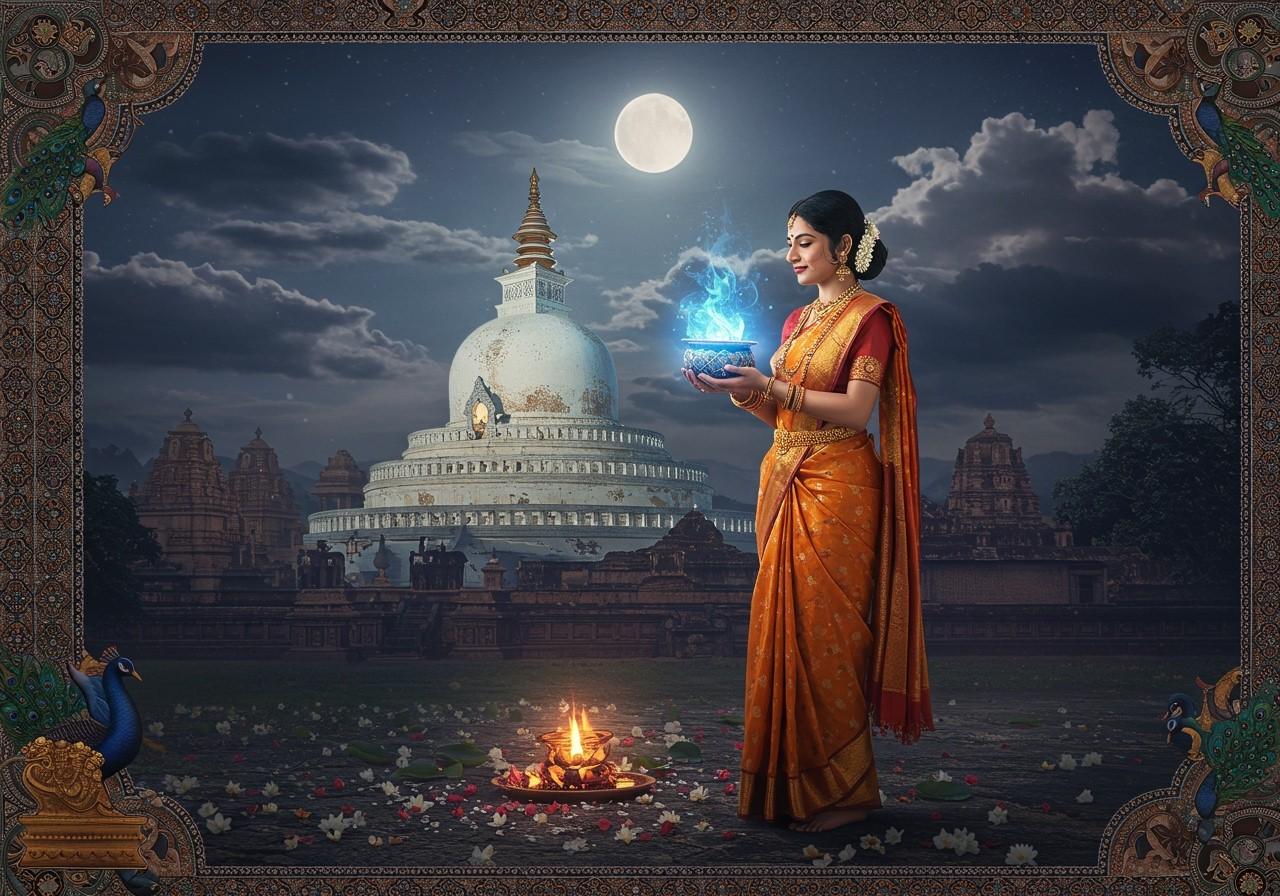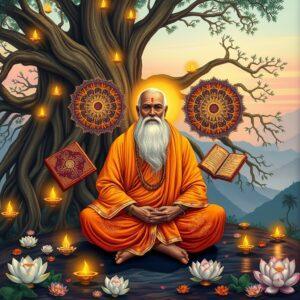
Dive into the captivating world of ancient Tamil literature with Manimekalai, a revered epic among the five great epics of Tamil literature. Composed during the Sangam era (between the 2nd and 6th centuries CE), this literary masterpiece offers a glimpse into the rich tapestry of ancient Tamil poetic skill. It also provides valuable insights into the socio-cultural and religious landscape of that period. This exploration delves into key aspects of Manimekalai, including its authorship, historical context, and religious significance.
Authorship of Manimekalai
Unraveling the mystery surrounding the authorship of Manimekalai leads us to Seethalai Sataṉar, a distinguished poet and Buddhist monk. His deep immersion in Buddhist philosophy profoundly influenced his writing, shaping the epic’s themes and messages. Seethalai Sataṉar’s unique narrative techniques and literary style, evident in the epic’s verses, distinguish him as a remarkable storyteller. Historical records corroborate his authorship, solidifying his place in Tamil literary history.
- Seethalai Sataṉar’s Background: His life as a Buddhist monk significantly shaped the themes and messages woven into the narrative of Manimekalai, imbuing it with spiritual depth and philosophical insights. His monastic experiences likely provided him with a unique perspective on life, renunciation, and the pursuit of enlightenment, which are reflected in the epic’s narrative.
- Literary Style: Seethalai Sataṉar masterfully employed various poetic devices and storytelling techniques to craft a compelling narrative. His skillful use of imagery, metaphors, and other literary elements enhances the epic’s aesthetic appeal and contributes to its enduring literary value. The epic’s structure, organization, and use of poetic devices showcase the author’s literary prowess.
- Historical Records: Numerous historical references and scholarly works attribute the authorship of Manimekalai to Seethalai Sataṉar. These historical records serve as strong evidence supporting his claim as the creator of this revered Tamil epic. The consistent attribution across different sources reinforces the consensus on his authorship.
Historical Context of Manimekalai
Manimekalai is rooted in the late Sangam period, a significant era in Tamil history. Dating back to between the 2nd and 6th centuries CE, the epic reflects the socio-political dynamics, religious influences, and cultural nuances of this time. Understanding this historical context is crucial for a deeper appreciation of the epic’s narrative and its enduring relevance.
- Socio-Political Landscape: The epic offers a glimpse into the socio-political landscape of Tamil Nadu during the Sangam period. It portrays the social structures, political systems, and power dynamics that shaped the lives of people in that era, providing valuable historical insights.
- Influence of Buddhism and Jainism: Manimekalai highlights the growing influence of Buddhism and Jainism in Tamil Nadu during the Sangam period. These religions played a significant role in shaping the intellectual and cultural landscape, impacting literary works like Manimekalai. The epic reflects the coexistence and interaction of different faiths during that time.
- Key Historical Events: While the epic primarily focuses on the protagonist’s spiritual journey, it also alludes to key historical events and figures that may have influenced the narrative or the socio-cultural context in which it was written. Further research can shed light on these potential connections and enrich our understanding of the epic’s historical backdrop.
- Urban Settings: The epic vividly depicts the urban settings of Puhar (Kaveripattinam) and Madurai, prominent cities during the Sangam era. These descriptions provide valuable insights into the urban life, architecture, and social interactions of that time.
- Trade and Commerce: Manimekalai also touches upon the significance of trade and commerce in the Sangam period. The epic’s narrative may reflect the economic activities and trade routes that connected Tamil Nadu with other regions, adding another layer to our understanding of the historical context.
Religious Context of Manimekalai
As a Buddhist epic, Manimekalai is imbued with significant religious themes and philosophical underpinnings. Understanding the religious context is essential for interpreting the protagonist’s journey and the underlying messages conveyed in the narrative.
- Buddhist Philosophy: Manimekalai showcases core principles of Buddhist philosophy, including karma, rebirth, and the pursuit of enlightenment. The epic serves as a vehicle for disseminating Buddhist teachings and exploring the path to spiritual liberation.
- Protagonist’s Journey: Manimekalai’s journey is not merely a physical one but also a profound spiritual quest. Her transformation from a princess to a Buddhist nun reflects the path towards enlightenment, emphasizing renunciation, compassion, and the pursuit of wisdom.
- Depiction of Buddhist Monastic Life: The epic provides glimpses into Buddhist monastic life, including the practices, rituals, and community dynamics within monasteries. This portrayal offers valuable insights into the religious and social aspects of Buddhist monasticism during that era.
- Supernatural Elements: Like many epics, Manimekalai incorporates supernatural elements and divine interventions. These elements are often integrated into the Buddhist lore, adding a layer of mystique and wonder to the narrative while reinforcing the influence of Buddhist beliefs.
Connecting with Manimekalai’s Teachings through Poojn.in
Poojn.in offers a curated selection of products that can enhance your understanding and appreciation of Manimekalai’s spiritual and cultural significance:
- Pure Brass Buddha Statues: Deepen your connection with the Buddhist teachings central to Manimekalai with our authentic brass Buddha statues. These exquisite pieces are ideal for creating a serene atmosphere in your home shrine or meditation space.
- Meditation Cushions: Enhance your meditation practice with our comfortable and supportive meditation cushions, enabling you to engage in contemplative practices inspired by Manimekalai’s themes of mindfulness and self-reflection.
- Traditional Oil Lamps (Vilakku): Illuminate your space with the warm glow of traditional Tamil brass lamps, evoking the sacred ambiance depicted in Manimekalai’s temple scenes. These lamps can enhance your spiritual practice and create a serene environment for studying the epic.
- Incense and Holders: Create a peaceful and contemplative atmosphere with our selection of natural incense and intricately designed brass holders. The fragrant aromas can enhance your focus and create a serene setting for reflecting on Manimekalai’s profound message.
Visit Poojn.in to explore our complete collection of authentic ritual items and cultural goods. We provide secure packaging, fast delivery across India, and expert guidance on product selection. All items are backed by our quality assurance and come with proper certification where applicable. [Note: Product availability may vary. Please check the website for current stock and prices.]
Conclusion
Manimekalai transcends the boundaries of a simple ancient Tamil epic; it stands as a testament to the rich history, culture, and religious thought of the Sangam era. By delving into its authorship, historical context, and religious significance, we gain a profound appreciation for the enduring legacy of Tamil literature. This exploration allows us to connect with the traditions and values that have shaped Tamil society for centuries. Manimekalai’s timeless wisdom continues to resonate, inviting us on a journey through time and inspiring us with its profound message.


